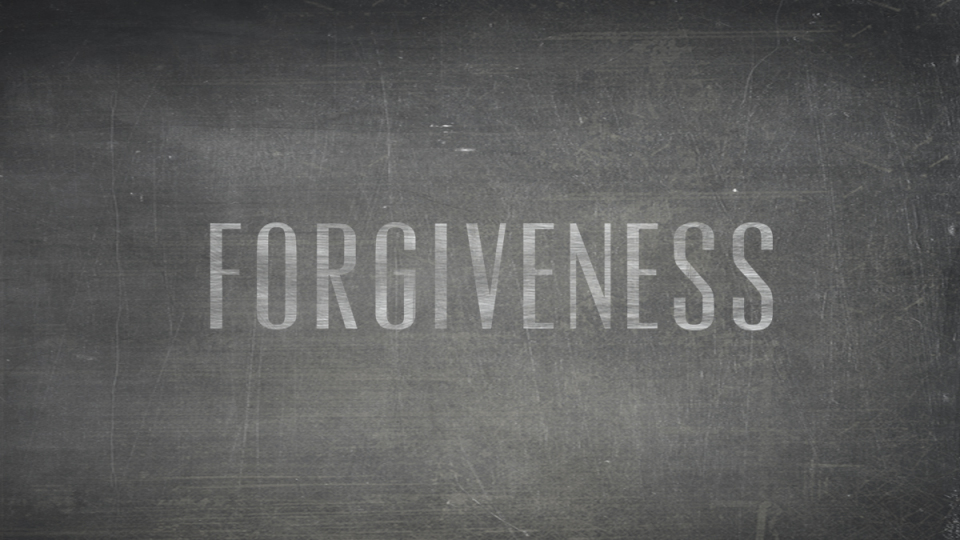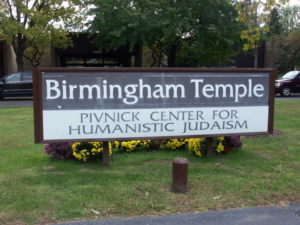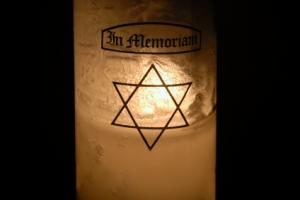Forgiving the Unforgivable
If you woke up and your spouse and two kids were gone. . .How could you forgive the person who did this?

“I got a call from the hospital saying ‘We have Sam.’ He was my youngest,” Gary told me. “I jumped in my car to rush to my boy without asking why. I called my wife’s cell phone, but it went to voicemail. I dialed my older son’s. Voicemail too. Helicopters were flying above. I wondered how Sam got to the hospital. My mind couldn’t process what was happening.”
Gary and I were sitting in the lobby of my hometown’s Maple Theatre in Birmingham, Michigan, after the screening of Transforming Loss, my best friend Judy Burdick’s poignant 2013 documentary. Desperate for insight about forgiveness, watching six families coping with sudden death, I was riveted by Gary Weinstein’s story. Eight years before, a car accident had killed his 9-year-old son Sam, 12-year-old son Alex, and his wife, a pretty 49-year-old business coach with red curly hair, who had glasses, like him. The widowed jeweler made national news by publicly forgiving the drunk driver who’d killed his family. After the Q & A, I’d introduced myself, anxious to understand how he could forgive something that seemed so unspeakable.
At 55, five foot five, slim and balding, Gary reminded me of the nice, brainy, self-effacing Jewish guys I grew up with (and the one I married). As we sat on a bench, he retraced Tuesday, May 3, 2005, when his wife Judith had picked up their sons from school to take Sam to the orthodontist and Alex to Birmingham Temple for his Bar Mitzvah practice. They were on 12 Mile Road, east of Orchard Lake.
I knew the intersection, near my childhood home. I’d had an accident on that road when I was sixteen, emerging unscathed but destroying my car. I didn’t drink or toke the night of my crash but I’d operated a vehicle high before. Hearing Gary’s enormous loss, I was myopically mortified to think that driver could have been me. I was an addict, “still recovering, never recovered” according to Dr. Winters, the substance abuse specialist I’d recently fallen out with. After a 15-year close connection where he helped me get clean and sober, our estrangement – and my inability to forgive him without an apology – had motivated me to learn more about forgiving. But now, like an inverted bizarro It’s a Wonderful Life, I felt him taunting me with the damage I could have caused, had he not intervened.
“When I reached Beaumont Hospital, they escorted me to a waiting room for relatives,” Gary spoke slowly.
I pictured Beaumont’s medical complex, where my father worked as a physician for decades.
“The doctor said my wife and sons had been in a car crash. They did everything for Sam but he didn’t make it,” Gary said.
“Do you mean no one made it?” I asked.
He confirmed: “No one made it. My kids and wife were gone in an instant. For twenty years Judith was my best friend, co-parent, business advisor, golf partner, fellow traveler. I lost everything. I was alone. My life was over.” He sounded distraught, as if it happened yesterday.
Gary offered details of his family’s final hour: Judith was waiting in the center lane to turn into the parking lot when a GMC Yukon Denali rear-ended her and drove over her Honda Accord, pushing her into oncoming traffic, flattening her and Alex in the front seats. The Denali crashed into a Jaguar in the next lane, then rolled over and struck a Ford Escort. The other drivers escaped physically intact, but pictures of the site showed four vehicles totaled beyond recognition. Judith and Alex were pronounced dead at the scene. Upon impact, Sam was ejected from the car to the parking lot driveway 25 feet away. Two witnesses rushed to his aid. He was breathing, but unconscious. They stayed with him until paramedics sped him to the hospital.
At a news conference that day, the police chief said the driver’s blood alcohol level was four times the legal limit, the highest ever recorded by the precinct. The chief was amazed that Thomas Wellinger, a sales director, could still drive; someone with numbers that high usually ended up in a coma or dead from alcohol poisoning. He was charged with three counts of second-degree murder. Along with his broken neck, Wellinger was suffering with tremors from severe withdrawal. His car’s “black box” showed he’d been going 70 miles an hour and hadn’t tried to hit the brakes before ramming into Gary’s wife. Wellinger was arraigned in his bed at Beaumont, the same hospital where Gary’s youngest son was declared dead.
“I was planning a secret romantic getaway weekend for our 20th anniversary,” Gary revealed.
“I’m so sorry,” I said. “I can’t even imagine…”
“I called my parents and siblings, who dropped everything to run to me.”
“You’re from around here?” I asked. “Can you tell me about your background?”
“I’m the youngest of six kids. I grew up in a house full of love,” he said. After trouble with reading, they held him back a year. He was a theater nerd at Southfield Lathrup High School, where he found his passion was entertaining people on stage.
I’d also grown up in Southfield and bet my parents knew many of the fifteen hundred people who attended the funeral, including classmates of Gary’s sons, who’d brought stuffed animals and candy. Gary had his wife and children cremated, their remains buried in a memorial garden at their temple. That struck me as unusual. According to the laws of our people, dead bodies were to be returned to the earth as undamaged as possible. Cremated remains were usually not interred at cemeteries for Jews. When Gary said he belonged to Birmingham Temple, I understood. I knew their founder, Rabbi Sherwin Wine. 
“Oh I adored Sherwin,” I jumped in. “He was our close friend’s Rabbi.” I was surprised someone who seemed as mainstream as Gary was a follower of the Midwest’s infamous intellectual gay atheist leader, who didn’t believe in God and ran a Humanist congregation. I wanted to ask if he knew the Greenwalds but caught myself before playing Jewish geography during a talk of Gary’s wife’s death.
He spoke of the slow days following the tragedy. “It was a dark time, devastating, surreal.” He called upon what he’d been taught at The Landmark Forum’s “personal development” workshops he’d taken years before the crash. The “transformative learning” center’s creed was to take complete responsibility for your life and inspire others. Asked to design a possibility of who he could be, Gary described his potential self as full of “aliveness, fun and joy,” traits he wanted to achieve through creativity, participation in the world, and tzedakah, Hebrew for righteousness. He recalled the prophetic instructions to avoid letting past pain define you.
I remembered a classmate who’d referred to EST (Erhard Seminar Training), the earlier program of Landmark’s leader Werner Erhard (born John Rosenberg), as cult-like, while the New York Times had called it “equal parts Zen Buddhism and Dale Carnegie.” But who was I to judge? I’d found my intense addiction therapy with Dr. Winters mind-blowingly helpful, even as colleagues criticized it as unorthodox. Meanwhile I felt bonded with Gary over our liberal views, psychological searching, and love of the Midwest’s most controversial clergy. I saw why the filmmaker Judy, a psychotherapist who’d been widowed young, featured Gary in her movie. I asked him if Landmark’s focus on taking control of your life and not blaming others meshed or clashed with Birmingham Temple‘s view that we shaped our own destiny without ancient traditions or supernatural authority.
“They mapped very well together,” Gary explained. “They helped me separate my horrible loss from who I was – and still am. Though I loved my family, I was not my family. I was still me. To not have them did not make myself go away.”
***
Discussing the Jewish Humanistic outlook on forgiveness, Gary referred me to Tamara Kolton, the rabbi who’d presided over his wife and sons’ funerals.
“I was close with the family. I was at our summer camp with Alex and Sam,” said Kolton, a vivacious blonde from Michigan. “Here’s what I remember. Right after they died, Judith and Alex’s spirits came to me in the middle of the night.”
“In a dream?” I asked.
“It felt real,” she said. “Alex said he still wanted to have his Bar Mitzvah in the fall. And Judith -who was always encouraging me to go to Landmark – told me to try it. The next day I called my mom to tell her, wondering why Sam hadn’t come too.”
“What did she say?”
“She said that Sam didn’t have any unfinished business with me,” Kolton went on. “I didn’t want to try Landmark. Mom told me I didn’t have to go. ‘You mean you don’t have to obey spirits?’ I asked her, amazed. It was the first time I’d ever been visited by the dead; I wasn’t sure of the rules.”
As a shrinkaholic poet whose mother (née Miriam Goodman) always told me “The Goodman women were witches,” I respected the literary logic of Tamara’s apparitions.
“Did you tell Gary?” I asked.
 “Yes! And we had a posthumous Bar Mitzvah for Alex at the Temple. It was joyous, not the least bit maudlin. Gary was a great father.”
“Yes! And we had a posthumous Bar Mitzvah for Alex at the Temple. It was joyous, not the least bit maudlin. Gary was a great father.”
I gathered this was real life, not a dream. “Did Rabbi Sherwin Wine know about your spiritual encounter?”
“No way,” she said. “My supernatural powers were too far out – even for him.” She laughed, adding that her clairvoyance and radical feminism led her to leave the temple to strike out on her own.
“From a religious view, were you pushing Gary towards forgiving the drunk driver?”
“No. That was all Gary. If I woke up one morning and my spouse and two kids were gone, I might want to check out, to go be with them. How could you live or forgive the person who did this? Gary is a fucking miracle. I call him ‘a light worker on the planet earth.’ I follow his lead. He’s like my Rabbi.”
***
Not long after the 2005 crash, Gary’s jewelry store was destroyed in an electrical fire. With a settlement from Wellinger’s insurance, he rebuilt his business. Yet calamity kept striking. In 2007, Gary lost his mother, followed by his aunt. Then his older brother died at 52 of a heart attack. Rabbi Sherwin Wine died in a car crash in Morocco. Mourning his wife, sons, mother, brother, and rabbi left Gary too traumatized to return to work for four and a half years. He seemed like Job, a righteous man who suffered excessive loss. Yet he wasn’t self-pitying. He described his grief as “a brick in my pocket. It didn’t go away, though I learned I could handle it. I realized I was strong enough to carry the weight and move on. I had the brick, it didn’t have me.”
He sounded so stoic and matter-of-fact. I questioned whether it was Gary’s spirituality, rationality, illogicality, or psychological tenets that allowed him to be so forgiving.
“When I heard a drunk driver caused the crash and was five times over the legal limit from vodka at 3 in the afternoon, I knew he was very sick,” Gary said. “I didn’t hate Thomas Wellinger, I hated what he did. That’s a distinction I made. Maybe I wasn’t totally free of culpability. Who didn’t I stop from drunk driving in the past?”
In the film, he’d cried reliving what happened. For Gary’s “victim impact statement” he wrote a letter to his wife saying how heartbroken he was to cancel their twentieth anniversary party and how distraught he felt to lose his sons and his legacy. Even harder was losing the contributions his kids might have made to the world. The letter was read at the sentencing trial. Wellinger pleaded no contest. From the Oakland County Jail, a sober Wellinger sent Gary a handwritten letter filled with remorse and regret.
“So I decided to meet him a year after the crash,” Gary said.
“What did you want?”
He shrugged. “I had no agenda. As a father, the first thing I asked was how his children were. He said he hadn’t seen his son since the crash. The jail didn’t allow minors inside.”
Gary told him, “I haven’t seen mine either.”
“Can you ever forgive me?” Wellinger asked.
“Can you ever forgive yourself?” Gary responded.
Wellinger had been sober for 17 years before relapsing. That day he’d been on his way to see his psychiatrist, having taken an antihistamine and an anxiety drug. Drinking again on medication made it much worse.
I hated to find myself identifying with Wellinger. As an addict, I had needed Dr. Winters to get smoke-drug-and-alcohol free at age 40. I silently thanked Winters for getting me clean.
Gary was also struck by his similarities to Wellinger, who was three years older than him. “He lived less than a mile away. Since our last names started with WE, we were on the same phone book page. Our kids were in the same school district.” Wellinger had no recollection of the accident or that he’d swerved over lanes. A newspaper said the reason he didn’t use his brakes was because he’d been blacked out for miles.
Gary’s wife, Judith, was a Humanist like her husband, not believing in God or an afterlife. Gary was sure she’d want him to forgive the man who killed her. Since he saw alcoholism as a disease that caused the crash, blaming Wellinger would be like blaming someone for having cancer.
Wellinger was convicted of three counts of second-degree murder, sentenced to 30 years with no chance of parole for 19. He had to pay reparations to Gary.
 “He wasn’t in good health,” Gary said. “He wasn’t likely to get out of jail. If he did, I requested that he never be allowed a driver’s license again. So a year after the tragedy, I publicly forgave him.”
“He wasn’t in good health,” Gary said. “He wasn’t likely to get out of jail. If he did, I requested that he never be allowed a driver’s license again. So a year after the tragedy, I publicly forgave him.”
It seemed a beautiful gesture. Yet sometimes forgiving came with a cost. Gary shared the messy fallout: Judith’s relatives refused to pardon Wellinger – or Gary. “My forgiveness caused contention. I was basically ex-communicated from her family,” he admitted. “The discord started after the funeral.”
Forgiving a stranger divided his family. Or did they object to the burial decisions he’d made? Both of Judith’s sisters requested some of her remains. “Why aren’t there more ashes?” one asked Gary.
“How many ashes do you need?” he’d replied.
“We had to go back to the temple to dig up ashes so they could get more,” he said.
I wondered if Gary’s reconnection with his ex-girlfriend Eileen Keegan was the hidden source of his sister-in-laws’ ire. Gary originally met Eileen on a senior class trip to Miami when he was 18, along with her father who was the stage manager of shows at the Fountainbleau Hotel. Eileen was Gary’s first love. She flew in for Southfield Lathrup’s senior prom, a memorable night, and they dated for 2 years. Yet at 20, Gary wasn’t ready to marry and they lost touch.
Gary met Judith in 1984. She was out at a local club with friends. “It was the day Marvin Gaye died,” he said. “We danced to ‘Sexual Healing.’ I was too shy to ask her out. Before I left, Judith’s girlfriend said, ‘she wants you to have her number.’ I didn’t have paper. I wrote it on a dollar bill I kept for years,” he recalled with a shy smile.
They wed in 1985 when Gary was 27. After two decades, they were planning their eldest son’s Bar Mitzvah. In Gary’s theater group production The Wonderful World of Oz, Gary was playing the scarecrow. Sam was a Lollipop Kid, Alex a flying monkey. “Alex had good lines. It was an important role,” Gary recalled.
When the musical ended, Gary planned to go to a jewelry show in Las Vegas, where Mr. Keegan lived. Gary called him to reconnect. Mr. Keegan mentioned that his daughter Eileen, now divorced, lived there too, suggesting they all get together. That never happened. After the car crash, Gary cancelled his trip. Eileen phoned her condolences, asking if it would be appropriate to attend the funeral.
“I can use all the friends I can get now,” Gary said, still shocked.
Eileen came, blown away by the support Gary had. Twenty-nine years after their prom date, they wound up rekindling their romance.
“Did having Eileen there help you cope?” I asked.
“Yes, leaning on someone made it easier,” he said. “I believed that love could heal all and Judith would want me to keep living. Forgiving Wellinger seemed critical. If I held onto regrets and rage, it would keep me miserable in the past, away from my future.”
Eileen moved to Michigan for Gary in 2011. With her by his side, he didn’t feel isolated or bitter. “She’s over there.” Gary pointed to a woman with salt-and-pepper hair talking with the film crew. “Eileen’s birthday is June 22, same as Judith’s.” The incredible coincidence seemed like fate.
“Did your psychological beliefs push you towards forgiving too?” I asked.
“Yes, I had a strong sense of who I was, even while mourning,” he said. “I refused to hate Tom. I hoped to contribute to conversations about how forgiveness and healing could come from traumatic loss. Without my wife and sons, I needed a way to do good in the world. I am not what happened to me.”
“I am what I choose to become,” I jumped in to finish the famous Carl Jung quote.
“No, I would say ‘I choose what I have,’” Gary said, which I took to mean self-acceptance was his ambition at this stage of life.
While you couldn’t erase your suffering, I liked that you could choose what you did with it. Gary launched a charity, offering theater scholarships so other children could enjoy the stage like his sons had. He gave talks to schools on the perils of drinking and driving. He joined the nonprofit Project Forgive. Talking about the film and his speeches on forgiveness, this soft-spoken Southfield man gained stature. His capacity for forgiving astounded me. I couldn’t forgive Dr. Winters for a mistake that had hurt my feelings, while Gary exonerated a man for the triple murder of his family.
Wellinger had explained his alcoholism, begged for forgiveness, was jailed and made financial restitutions. The public, of course, took Gary’s side, punishing the criminal behavior. If a good apology required an acknowledgment of the offense, explanation, remorse, and reparations, Gary received it from Wellinger – and his community. Did getting a perfect apology encourage Gary’s magnanimity? Was it easier to forgive a stranger than someone close to you? If there were an equation for who could forgive, I bet Gary’s happy childhood and easygoing personality helped (while my role model was Sylvia Plath).
Leaving the screening, I bumped into my buddy Andy who’d gone to school with Gary.
“What was he like as a kid?” I probed.
 “Gary was the oldest in our grade, the first with a mustache and jean jacket,” Andy said. “We called him Head, for ahead. He was like The Fonz. He’s been acting since sixth grade. He played the rich butcher in Fiddler on the Roof. He was really good.”
“Gary was the oldest in our grade, the first with a mustache and jean jacket,” Andy said. “We called him Head, for ahead. He was like The Fonz. He’s been acting since sixth grade. He played the rich butcher in Fiddler on the Roof. He was really good.”
Andy forwarded me Gary’s senior photo (cute with shaggy bangs and big ears) and recent Facebook shots of him in costume for his theater ensemble’s The Diary of Anne Frank and How to Succeed in Business (Without Really Trying). Gary seemed alive, joyous and popular. But was Public Forgiver another role he played? It felt like a piece was missing.
Researching Gary’s case further, I stumbled on a messier coda. The news reported that Wellinger had shown up to work drunk that fatal morning and was sent home. Instead of calling him a cab or having someone drive him, his boss at the Texas-based manufacturer knew Wellinger was getting behind the wheel. Employees confirmed that this boss had scheduled an intervention the week before to confront Wellinger about his alcoholism. Wellinger never showed up. Gary brought a wrongful death civil lawsuit against the company. His lawyers argued gross negligence, since they knew he was driving drunk and willfully looked the other way for six months before the crash. Lawyers proved Wellinger drank 6 ounces of vodka before 10 a.m. A co-worker said that after lunch, Wellinger “came behind me and playfully hit me in the back. He was grinning, in a boxer’s stance. He looked scary, with a wild look in his eyes.” At 2:45 he left for his fateful doctor’s appointment.
Gary was upset that a federal jury ruled in the company’s favor. “I want to thank everyone who supported my effort to seek justice for my family,” Gary stated. “I used part of the insurance settlement for charitable foundations to enrich lives of children in this great country that my wife and sons will never see again. This lawsuit isn’t about money. It’s a call to action to make a corporate giant step up. They should be punished for allowing a drunk employee to be a menace on the road and kill people.”
It was satisfying to hear Gary sound angry, even at a corporation. It made him more human.
“You speak about this so calmly. As an actor, do you compartmentalize?” I asked.
“Maybe I was playing the role of moral outrage, demanding accountability,” he said. “I believed a debt should be paid. At the civil trial, Wellinger’s coworkers admitted they’d lied to cover up his alcoholism. Everyone knew he was always drunk at work. Colleagues cleared out the booze in his refrigerator. The judge claimed this testimony came too late. “There’s a difference between a bad accident and willful deception.” Gary added one stunning new fact: He’d learned that Wellinger’s intervention had been scheduled for May 3, the day of the crash.
“My wife used to say, ‘You need something to look forward to,'” Gary said. “For me that was raising our sons. Suddenly they were gone. Thinking of when she’d joked that I was happiest on the golf course, I set up a golf road trip to play championship courses in all 50 states. Talking about my loss is also therapy. When you repeat the painful details almost daily, they lose their charge.”
Was that why he’d sounded so composed when telling me what he’d been through? I thought of Freud’s repetition compulsion theory, where you subconsciously repeat a traumatic event to master the torment so it’s not controlling you.
“I learned to wait until the 18th hole to reveal my past,” Gary added. “If I shared what happened with other golfers too early, people felt uneasy and treated me differently. In a hotel lobby I read about the birth of Tiger Woods’ first child, Sam Alexis. It made me happy to think she has the same name as my boys. Playing golf with a father and his 16-year-old son, Sam’s age, I pictured Sam as a running back on the football team. I imagined Alex in college at Michigan State like his mother.”
This brought me to tears but Gary seemed at peace. His spiritual attitude had created the externals that allowed him to forgive. I wished I could be more like him.
***
Leaving the movie theatre, I went back to my parents’ house where I was staying for the week. My folks were still up, having coffee at the kitchen table. I felt lucky they were always there for me.
“How was Judy’s documentary?” Mom asked, putting down The Detroit News.
“It was brilliant. And gut-wrenching,” I answered. “Dad, what were you doing at Beaumont Hospital in 2005?”
“I was the medical director overseeing patient care. Why?”
“I spoke with Gary Weinstein, who was in the film. He rushed there when they tried to save his son after a car crash.”
“That would have been the trauma unit,” Dad said.
“I remember that horrible news,” Mom jumped in. “His wife and little boys were killed by that drunk driving idiot.”
I nodded. “Isn’t it odd that, as a Jew, he picked cremation over burial?” I asked. “I read that, after the crematoriums at concentration camps, it was taboo for us to burn ourselves, even after death.”
“Many Jews don’t feel that way anymore. My cousin Big Jack chose cremation,” my dad, also named Jack, said. (I loved that their rich relative Jack on Dad’s side generations ago led his family to name their kids Big Jack, Little Jack, Jacob, Yaakov in Hebrew, Yonkel in Yiddish, and Jacqueline).
“It’s cheaper,” Mom said. “Cremation is only about $1,500. A burial could be $15,000. The maintenance can be expensive. Not that many mourners still visit gravesites.”
She was right. I felt guilty we’d hardly visited my husband’s father at his Westchester cemetery.
 “Money’s not the only reason,” Dad interrupted. “It’s because it gives the mourners more choices and control. Remember our neighbor Jim who loved trains? After he passed away, his wife spread his ashes at the Pontiac railroad tracks. And when Big Jack died, his wife wanted him closer. You can take the remains home with you in an urn, to keep your loved one nearby.”
“Money’s not the only reason,” Dad interrupted. “It’s because it gives the mourners more choices and control. Remember our neighbor Jim who loved trains? After he passed away, his wife spread his ashes at the Pontiac railroad tracks. And when Big Jack died, his wife wanted him closer. You can take the remains home with you in an urn, to keep your loved one nearby.”
Since when was my father the romantic?
I assumed only Reform or Humanistic rabbis like Gary’s would accept cremation. Dad surprised me by saying our Conservative rabbi, Joseph Krakoff, compromised. While trying to discourage a member of their synagogue from being cremated, Krakoff made sure their cemetery had a separate section for it. Burying at least the remnants of the body was better than scattering them in the wind, adhering closer to the biblical mandates to bury the dead, and the Genesis line, “From dust you came, to dust you will return.”
“The only caveat is that you can’t reserve cremation space in advance,” my father added.
“Why not?”
“You know rabbis, they keep trying to talk you into doing it their way until the last second,” he said, laughing.
“Dad, one more question,” I said. “The driver who crashed into Gary’s family had a blood alcohol level five times the legal limit, the equivalent of 22 vodka shots. His black box showed he was driving way over the speed limit and never even hit his brakes. The paper said he’d been blacked out for miles while still driving. Is that possible?”
“He could have been so drunk he was in and out of consciousness. What happened to him?” Dad asked.
“Broken neck, but he survived,” I reported. “He got 19 to 30 years in jail.”
“Good,” said my father, unforgiving.
Susan Shapiro, an award-winning NYU and New School professor, is the bestselling author/coauthor of 12 books her family hates, including Five Men Who Broke My Heart, Lighting Up, The Bosnia List and The Byline Bible (all available from Penguin Random House). This is from her memoir-in-progress The Forgiveness Tour: How to Find The Perfect Apology. Follow her on Twitter at @susanshapironet and on Instagram at @profsue123.
***
Published with support from the Henry R. Luce Initiative on Religion in International Affairs.